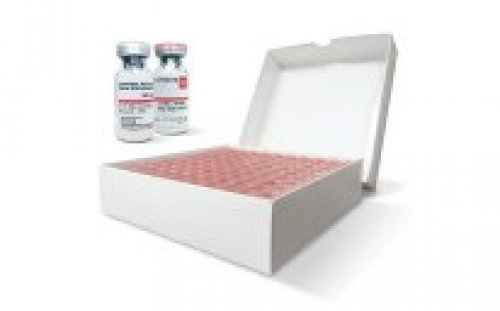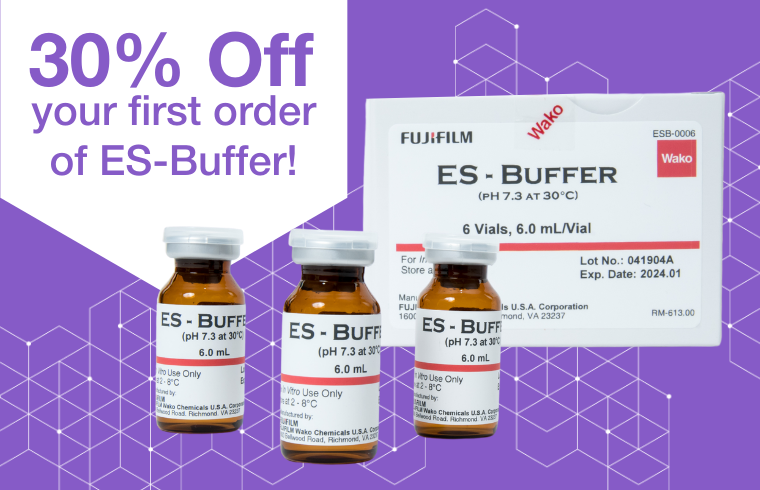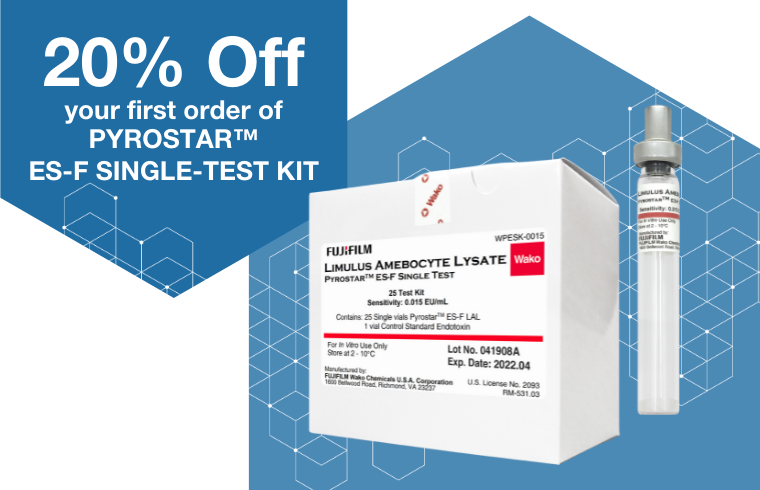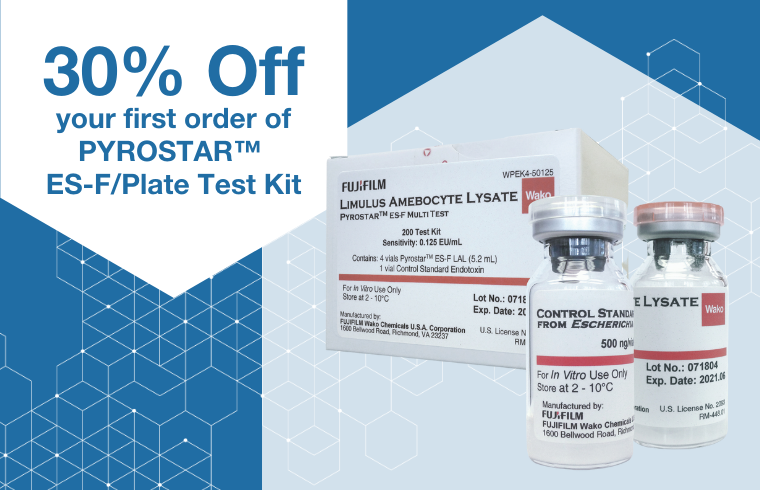
Kit of 100 PYROSTAR™ ES-F (5.2 ML) without CSE
PYROSTAR™ ES-F
Multi Test Vial (2.0 mL and 5.2 mL)
Intended Use: Limulus amebocyte lysate (LAL) is intended for the detection of gram-negative bacterial endotoxins. PYROSTAR™ ES-F is intended for the qualitative detection of endotoxins by gel-clot or quantitative detection by kinetic turbidimetric methods. The quantitative range for the Kinetic Turbidimetric Assay (KTA) is based on the lysate gel-clot labeled sensitivity, refer to the table below:
|
Gel-clot Labeled Lysate Sensitivity (EU/mL) |
KTA Quantitative Range (EU/mL) |
|
0.015 |
0.001 to 10 |
|
0.03 to 0.25 |
0.01 to 10 |
Summary and general information
Endotoxin (lipopolysaccharide or LPS) is a component of the outer membrane of Gram-negative bacteria. Since endotoxins, when injected or implanted, may cause fever and/or shock, the detection of bacterial endotoxins in pharmaceuticals and medicals devices is critical.
The LAL assay is the most sensitive method for the detection of bacterial endotoxins currently approved by the FDA.2 The first methodology used to determine the LAL test results was the formation of a gel-clot in the bottom of a glass reaction tube. It has also been observed that the test solution becomes turbid prior to gel-formation. The time required to produce a specified level of turbidity is inversely proportional to the amount of endotoxin in a sample.1
A photometric instrument such as the Toxinometer (Wako Pure Chemical Industries, Ltd.) is used to measure the rate of turbidity change. This quantitative measurement procedure is often referred to as the Kinetic Turbidimetric Assay (KTA).
By utilizing these properties, Wako Chemicals USA has developed an LAL endotoxin test that can be used either as a quantitative turbidimetric test or as a qualitative gel-test.
The USP Bacterial Endotoxins Test <85>6 provides standardized procedures for validation prior to routine use.
However, the specificity of LAL is not absolute.7 It has been reported that LAL reacts not only with endotoxin by also with β-1,3-glucan. Although the cascade system activated by β-1,3-glucan has been shown to be different than the one activated by endotoxin8, the end result, gel-clot formation is indistinguishable.
The activation of LAL by glucan in a sample can be prevented by adding a large amount of carboxymethylated curdlan (CMC) to LAL. The presence of large amounts of glucan does not interfere with the quantitation of endotoxin. Wako first made use of these findings by developing an ES-buffer, which contains high concentrations of CMC. When the ES-buffer is used to reconstitute LAL, the LAL reagent becomes endotoxin-specific. PYROSTAR™ ES-F is a new preparation of LAL in which CM-curdlan is colyophilized with LAL. Reconstituting PYROSTAR™ ES-F multi test vials with LAL Reagent Water results in an endotoxin-specific LAL reagent.
History and biological principle
The in-vitro detection of bacterial endotoxin was pioneered by Levin and Bang.3 Their findings showed that the blood of the horseshoe crab, Limulus polyphemus, clots in the presence of gram negative bacteria. They subsequently reported that all the components required for clot formation could be isolated from the circulating amebocytes found in Limulus blood.3,4
A guideline was released by the U.S. Food and Drug Administration in 19875 to inform manufacturers of human drugs and biologicals, animal drugs, and medical devices of procedures that FDA considers necessary to validate the use of LAL as an end-product endotoxin test. The FDA guideline was combined with the USP Bacterial Endotoxins Test in 2000 making the USP method the standard method for US manufacturers. The 1987 FDA Guideline was withdrawn in 2011.
Warnings and general precautions
PYROSTAR™ ES-F is intended for the in-vitro detection of gram-negative bacterial endotoxins. Exercise caution when handling LAL because its toxicity is unknown.
This test is not a diagnostic device and is not to be used to determine endotoxin levels in humans for diagnostic purposes.
Reagents provided
PYROSTAR™ ES-F Reagent: PYROSTAR™ ES-F is a lyophilized reagent containing Limulus amebocyte lysate, buffers, carboxy-methyl curdlan, monovalent and divalent cations.
Preparation: Tap the vial on a level surface to ensure that all powder is at the bottom of the vial. Gently remove the stopper and add 2 mL or 5.2 mL of LAL Reagent Water (LRW) to the vial. Replace the stopper and swirl gently to dissolve the contents without making contact to the stopper.
Storage: Store at 2 to 10oC. Refrigerate reconstituted reagent at 2-8°C, maximum 4 hrs or at -15±5oC for a maximum of 14 days. Reconstituted reagent can only be frozen and thawed one time.
Control Standard Endotoxin (CSE): A lyophilized reagent that contains refined endotoxin from E.coli and is used to confirm LAL reagent sensitivity, validate product test methods, and prepare inhibition controls.
Preparation: Release the vacuum by gently pulling up and removing the rubber stopper from the vial. The vial contains 500 ng of endotoxin. Each Control Standard Endotoxin is tested in comparison to the FDA Reference Endotoxin Standard and the conversion factor (EU/ng) is determined. The EU value (EU/vial) is printed on the label. Determine the volume of LRW to be added to the vial to produce a 1,000EU/mL solution. Add the determined volume of LRW to the vial. Replace the rubber stopper, invert the vial several times and vortex vigorously for 2 minutes.
Storage: Reconstituted CSE can be stored at 2-10°C for 1 month. CSE should not be stored at temperatures below freezing. When the stored solution is used, vigorously vortex the solution for 1 minute before use.
Materials and equipment not provided
Reference Standard Endotoxin (RSE): USP Endotoxin Reference Standard that has a defined potency of 10,000 USP Endotoxin Units (EU).
LAL Reagent Water (LRW): Endotoxin-free water.
Endotoxin free pipettes
Endotoxin free dilution tubes
Toxinometer Method
Toxinometer (Wako Pure Chemical Industries, Ltd)
Endotoxin-free test tubes and aluminum caps for Toxinometer
Gel-clot Techniques
Water bath or heating block incubator capable of maintaining 37 ± 1oC
Endotoxin-free test tubes and aluminum caps
Preparation of control standard endotoxin dilutions
Control Standard Endotoxin Preparation
Based on the information provided on the Certification of Analysis, prepare a CSE standard to a concentration of 1000 EU/mL, as described above. Vortex the 1000EU/mL CSE solution for 2 minutes at Room Temperature. Using the 1000EU/mL CSE solution, prepare the endotoxin dilution series as shown in Table 1 or 2.
Vortex each tube for 30 seconds between dilutions. Dilutions may be prepared in different volumes as long as the same ratio is maintained.
Table 1 Table 2
Sample Endotoxin Dilution Scheme Sample Endotoxin Dilution Scheme
(2 fold dilution series) (10 fold dilution series)
|
Initial endotoxin conc. (EU/mL) |
Volume added to LRW (mL) |
Final endotoxin conc. (EU/mL) |
|
Initial endotoxin conc. (EU/mL) |
Volume added to LRW (mL) |
Final endotoxin conc. (EU/mL) |
|
1000 |
0.4+3.6 |
100 |
1000 |
0.4+3.6 |
100 |
|
|
100 |
0.4+3.6 |
10 |
100 |
0.4+3.6 |
10 |
|
|
10 |
0.4+3.6 |
1 |
10 |
0.4+3.6 |
1 |
|
|
1 |
2.0+2.0 |
0.5 |
1 |
0.4+3.6 |
0.1 |
|
|
0.5 |
2.0+2.0 |
0.25 |
0.1 |
0.4+3.6 |
0.01 |
|
|
0.25 |
2.0+2.0 |
0.125 |
0.01 |
0.4+3.6 |
0.001 |
|
|
0.125 |
2.0+2.0 |
0.06 |
|
|||
|
0.06 |
2.0+2.0 |
0.03 |
||||
|
0.03 |
2.0+2.0 |
0.015 |
||||
|
0.015 |
2.0+2.0 |
0.008 |
||||
|
0.008 |
2.0+2.0 |
0.0039 |
|
|
||
Specimen collection and preparation
LAL reactions are pH sensitive requiring that the LAL and sample mixture have a pH of 6.0 to 8.0. PYROSTAR™ ES-F contains buffering components that help bring the test mixture within the pH range in most cases. If a pH adjustment is necessary, the pH of the sample should be adjusted with endotoxin-free HCl or NaOH.
Product Interference
Prior to using the LAL test for the routine release of product, it is necessary to validate the absence of product interference by performing an inhibition/enhancement test for each product type. A product is determined to be non-interfering by assaying a sample of the product spiked with a known amount of endotoxin and detecting 50 – 200% of the spiked endotoxin.
Kinetic Turbidimetric Assay (KTA): Prepare a standard curve that covers the testing range. Spike the product to a level of endotoxin that is equal to or near the middle of the standard curve. The product is determined to be non-interfering if the level of endotoxin reported is 50 to 200% of the spiked endotoxin concentration. For example, if a standard curve is run between 0.1 and 10 EU/mL, the product should be spiked with endotoxin to yield a concentration of 1.0 EU/mL. The acceptable endotoxin recovery is between 0.5 and 2.0 EU/mL.
Gel-clot Techniques: Two independent CSE dilution series are prepared using the product and LRW as diluents, respectively. Assay the CSE dilution series prepared in LRW in duplicate (n=2), and the CSE dilution series prepared in product in quadruplicate (n=4). The geometric mean endpoints of both dilution series must fall within two-fold of the labeled endotoxin sensitivity.
Kinetic turbidimetric assay procedure
A kinetic turbidimetric assay (KTA) can be performed on the Toxinometer and accompanying software (Wako Pure Chemical Industries, Ltd.).
In addition to the product being tested, a valid assay will include endotoxin standards bracketing the analysis range, positive product controls, and negative controls. All test values need to be determined from at least duplicate samples.
Toxinometer Method: Aseptically transfer 0.1 mL of PYROSTAR™ ES-F reagent into endotoxin-free toxinometer tubes. Add 0.1 mL of each product sample or control to the respective test tubes beginning with the negative control and ending with the highest endotoxin concentration. After each addition of each product sample or control, quickly mix the contents of the tube without foaming. Place the tube into the Toxinometer in the order of the assigned tube position. At the end of the incubation period, the Toxinometer software will perform regression analysis of the standard curve data and calculate endotoxin levels for each sample.
See “Bacterial Endotoxins Test” in The U.S. Pharmacopeia and refer to sections describing standard curve and preparation of solutions.6
Calculation of endotoxin concentration
During a KTA reaction the turbidity of the test solutions is continually monitored by the Toxinometer. The time required for a sample to reach a determined absorbance level over background is measured. This time is referred to by the Toxinometer software as Tg.
The software produces a log(x axis)/log(y axis) correlation of the Tg of each standard with its corresponding endotoxin concentration. An example of a standard series and recovery of an endotoxin spike of 1.0 EU/mL in product is presented below:
Representative Analysis
|
Standards |
CSE (EU/mL) |
Tg(min) |
Log Concentration |
Log Tg (min) |
|
|
|
|||||
|
NC |
0 |
NR |
------ |
------- |
|
|
STD1 |
10 |
8.0 |
1.000 |
0.903 |
|
|
STD2 |
1 |
13.2 |
0.000 |
1.121 |
|
|
STD3 |
0.1 |
23.6 |
-1.000 |
1.373 |
|
|
|
|||||
|
slope |
-0.2349 |
||||
|
y-intercept |
1.132 |
||||
|
coefficient of correlation |
-0.999 |
||||
|
Tg (min) |
Log Tg (min) |
Calculated EU/mL |
% Recovery |
||
|
Product 1 |
NPC1 |
NR |
------ |
------ |
------ |
|
PPC1 |
13.6 |
1.134 |
0.987 |
98.7% |
|
|
Product 2 |
NPC2 |
NR |
------ |
------ |
------ |
|
PPC2 |
13.0 |
1.114 |
1.196 |
119.6% |
|
NR= Nonreactive
In this example, the positive product control (PPC) for each product sample yielded endotoxin recovery consistent with the spiked level indicating there is no detectable product enhancement or inhibition. The negative product control (NPC) and negative control (NC) showed significantly lower endotoxin levels than the lowest standard endotoxin concentration.
Performance characteristics:
The linearity of the standard curve within the concentration range used to determine endotoxin levels must be verified. No less than 3 endotoxin standards, spanning the desired concentration range, and LRW water blank should be assayed in at least triplicate. Refer to the Verification of Criteria for the Standard Curve in USP. The absolute value of the coefficient of correlation, lrl, shall be greater than or equal to the value of 0.980.6
GEL-CLOT techniques procedure:
To ensure both the precision and validation of the PYROSTAR™ ES-F test, the sensitivity indicated on the label must be verified as described in USP Bacterial Endotoxins Test <85>.6
Each assay should include NC (negative control), 2λ PC (2λ CSE control), 2λ PPC (2λ positive product control) and the product to be tested, where λ is the PYROSTAR™ ES-F sensitivity.
1. Add 0.1 ml of the reconstituted PYROSTAR™ ES-F to each assay tube.
2. Aseptically transfer 0.1 ml of each product sample or control into each assay tube, beginning with the negative control and ending with the highest endotoxin concentration.
3. Quickly mix the contents of the tubes and incubate them undisturbed in a 37 ± 1°C heating block or water heat bath for 60 minutes ± 2 minutes.
4. After incubation, examine each tube for gelation. Each tube in the gel-clot method is interpreted as either positive or negative. A positive test is defined as the formation of a firm gel capable of maintaining its integrity when the assay tube is inverted 180°. A negative test is characterized by the absence of gel or by the formation of a viscous mass which does not hold when the assay tube is inverted.
5. Test results are only valid when the 2λ PC and 2λ PPC are positive, and the NC is negative.
Endotoxin assay by dilution series:
The sensitivity indicated on the PYROSTAR™ ES-F label can be confirmed by preparing a two-fold dilution series of RSE or CSE (with a confirmed potency) that brackets the stated sensitivity. The dilution series needs to be assayed in quadruplicate and include negative controls. The sensitivity is then determined by calculating the geometric mean of the obtained endpoints. An example of PYROSTAR™ ES-F with a labeled sensitivity of 0.125 EU/mL (λ) is described below:
Results Of Gel-Clot Assay
Endotoxin Dilution (EU/mL)
Replicate 0.25 0.125 0.06 0.03 NC End point Log10 End point
1 + + + - - 0.06 -1.222
2 + + - - - 0.125 -0.903
3 + + - - - 0.125 -0.903
4 + + + - - 0.06 -1.222
Convert each endpoint of the quadruplicate assay to its log10 value. The individual log10 values are averaged and the PYROSTAR™ ES-F sensitivity is taken as the antilog10 of this mean log value. The mean of the log10 value in the above example is -1.063 and the geometric mean (antilog10) is 0.087.
Determination of endotoxin in an unknown by gel-clot
To determine the endotoxin concentration of an unknown solution, test two-fold dilutions of the product until an endpoint has been reached. Calculate the geometric mean dilution factor and multiply by the labeled endotoxin sensitivity.
|
Product Dilution |
1/2 |
1/4 |
1/8 |
1/16 |
1/32 |
1/64 |
|
Dilution Factor |
2 |
4 |
8 |
16 |
32 |
64 |
|
Replicate 1 |
+ |
+ |
+ |
- |
- |
- |
|
Replicate 2 |
+ |
+ |
+ |
+ |
- |
- |
|
Endpoint Dilution Factor |
Log10 Endpoint |
|
8 |
0.903 |
|
16 |
1.201 |
|
Mean |
1.054 |
|
Antilog10 |
11.3 |
Endotoxin Concentration = 0.125 EU/mL times 11.3 = 1.4 EU / mL
Bibliography
1. Cooper, J.F., Levin, J., and Wagner, H.N. “Quantitative Comparison of in Vitro and In Vivo Methods for Detection of Endotoxin” J. Lab, Clin, Med., 78, p.128 (1971).
2. Hochstein, H.D. “The LAL Test versus the Rabbit Pyrogen Test for Endotoxin Detection; Update ’87.” Pharm. Technol., 11(6), p. 124 (1987).
3. Levin, J. and Bang, F.B. “Clottable protein in Limulus: Its Localization and Kinetics of its Coagulation by Endotoxin.” Thromb. Dieth. Haemonti., 19, p. 186 (1966).
4. Tai, J.Y. and Llu. T.Y. “Studies on Limulus Lysate, Isolation of Pro-clotting Enzyme.” J. Biol, Chem., 252, p.2176 (1977).
5. Guideline on Validation of the Limulus Amebocyte Lysate Test as an End-Product Endotoxin Test of Human and Animal Parenteral Drugs, Biological Products and Medical Devices. U.S. Dept. of Health & Human Services, FDA, December 1987.
6. “Bacterial Endotoxins Test.” The United States Pharmacopeia, most current version. U.S. Pharmacopeial Convention, Rockville, MD.
7. Cooper, J.F., Weary, M.E., and Jordon, J,T. “The Impact of Nonendotoxin LAL-Reactive Materials on Limulus Amebocyte Lysate Analysis.” L. Parent, Sci $ Tech, 51(1), (1966).
8. Tsuchiya, M., Oishi, H., Takaoka, A., Fusamoto, M. and Matsuura, S. “Discrimination between endotoxin and (1 – 3) beta-D-glucan using turbidimetric kinetic assay with Limulus amebocyte lysate.” Chem Pahrm Bull (Tokyo), 38(9). p. 2523 (1990).
Manufactured by:
Wako Chemicals USA, Inc.
LAL Division
1600 Bellwood Road
Richmond, VA 23237
License No. 1762





